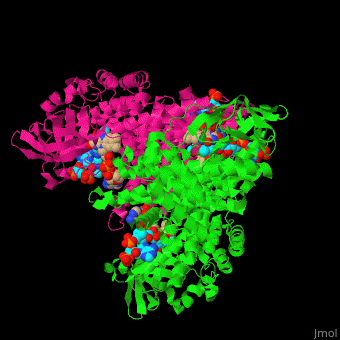Function
Acyl-CoA dehydrogenase (ACDH) catalyzes the introduction of a double bond between C2 and C3 of the thio-ester CoA substrate. This is the first reaction in fatty acid metabolism which produces acetyl-CoA. FAD is the cofactor of ACDH activity. ACDH is classified according to the length of its substrates as short- (SCAD), medium- (MCAD), very- and very long-chain (VLCAD) ACDH. MCAD can bind a broad range of chain length acyl-CoA substrates.[1] See also Beta oxidation and Glutaryl-CoA dehydrogenase.
- Glutaryl-CoA dehydrogenase is required for the metabolism of Lys, Trp and hydroxyLys.
- Isovaleryl-CoA dehydrogenase catalyzes the conversion of isovaleryl-CoA to 3-methylcrotonyl-CoA[2].
- 3-hydroxyacyl-CoA dehydrogenase oxidates straight chain 3-hydroxyacyl-CoA[3].
Disease
Impairment of the activity of ACDH causes a variety of diseases associated with lack of fatty acid metabolism. MCAD mutations are associated with Sudden Infant Death and with Medium-chain Acyl-CoA Dehydrogenase Deficiency (MCADD)[4]. For details see Investigating the Mechanisms of Active Site Mutations to the 1T9G WT MCAD Protein to Better Understand Medium Chain Acyl-CoA Dehydrogenase Deficiency (MCADD). SCAD deficiency is a recessive disorder of fatty acid β-oxidation.
Structural highlights
SCAD is a homodimer with a single FAD binding site. with 4 FAD binding sites in the subunits interface and 4 binding sites for acyl-CoA substrate within each monomer.
- One of the in homotetramer of rat ACDH. Water molecules are shown as red spheres.
- One of the in homotetramer of rat ACDH.[5]
3D structures of acyl-CoA dehydrogenase
Acyl-CoA dehydrogenase 3D structures

